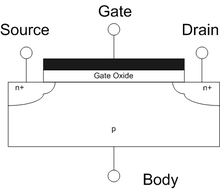Semiconductors/MOSFET Transistors
Insulated Gate Field Effect Transistors, or IGFETs are are very important part of modern electronics. IGFETs control the flow of current using an electrical field applied at a contact, called the gate, which is electrically isolated from the current-carrying medium.
In early FETs, the gate was made using metal, with an oxide (Silicon Dioxide (SiO2)), serving as the insulator, leading to the name Metal Oxide Semiconductor FETs, or MOSFETs. This name has stuck even though gates are now commonly manufactured using polysilicon. The name has, however, stuck, and MOSFET is generally synonymous with IGFET, with a few exceptions.
MOSFET Basics
[edit | edit source]MOSFETs have two regions, called the source and drain which are heavily doped. These are embedded in a substrate, which is doped the other way. The gap between the source and drain regions, which spans the substrate, is where the current will eventually flow. A layer of insulating oxide is placed over this gap (the channel), and on top of that, a gate contact, usually made of polysilicon.
The way a MOSFET works is to modify a thin layer of this gap, or channel, using an electric field that propagates through the insulation. This modification could be either increasing the current carrying capacities of the channel, or reducing it. Thus, we have two kinds of devices - enhancement mode MOSFETs and depletion mode MOSFETs. Depending on what kind of silicon is in the channel, a MOSFET can be p-channel or n-channel. A p-channel MOSFET has p-type silicon in the channel when 'on.' This will be explained more clearly soon.
MOSFET operation
[edit | edit source]
The operation of a MOSFET can be separated into three different modes, depending on the voltages at the terminals. For the NMOSFET the modes are:
Cut-off or sub-threshold mode
[edit | edit source]When
where
- is the threshold voltage of the device.
Here the switch is turned off, and there is no conduction between drain and source. While the current between drain and source should ideally be zero since the switch is turned off, there is a weak-inversion current, or subthreshold leakage. With MOSFET scaling subthreshold leakage composes a large percentage of total power consumption.
Triode or linear region
[edit | edit source]When
and
The switch is turned on, and a channel has been created which allows current to flow between the drain and source. The MOSFET operates like a resistor, controlled by the gate voltage. The current from drain to source is:
Saturation
[edit | edit source]When
and
The switch is turned on, and a channel has been created which allows current to flow between the drain and source. Since the drain voltage is higher than the gate voltage, a portion of the channel is turned off. The onset of this region is also known as pinch-off. In first approximation the drain current is now independent of the drain voltage, and the current is only controlled by the gate voltage:
In digital circuits the transistors are only operated in cut-off and saturation mode. The triode mode is mainly relevant for analog applications.





![{\displaystyle I_{D}\approx {\frac {\mu _{n}C_{ox}}{2}}{\frac {W}{L}}{\bigg [}2(V_{GS}-V_{T})V_{DS}-{V_{DS}}^{2}{\bigg ]}}](https://wikimedia.org/api/rest_v1/media/math/render/svg/9614b3214b058b6c93506399b0b2c504f65d7cee)

